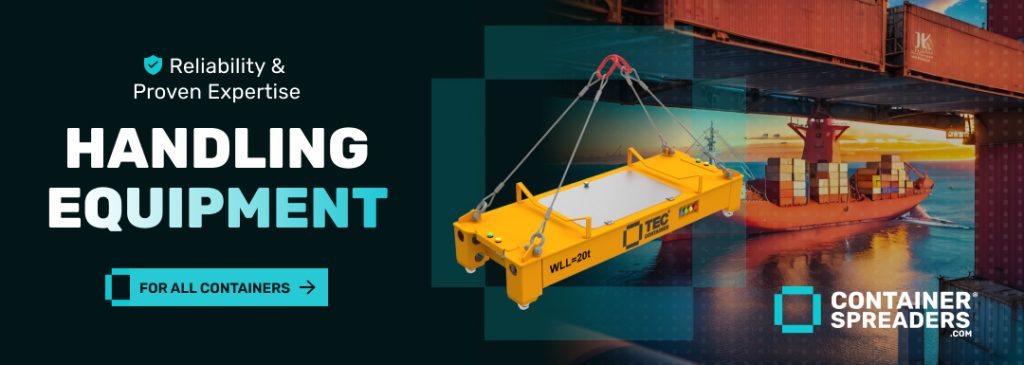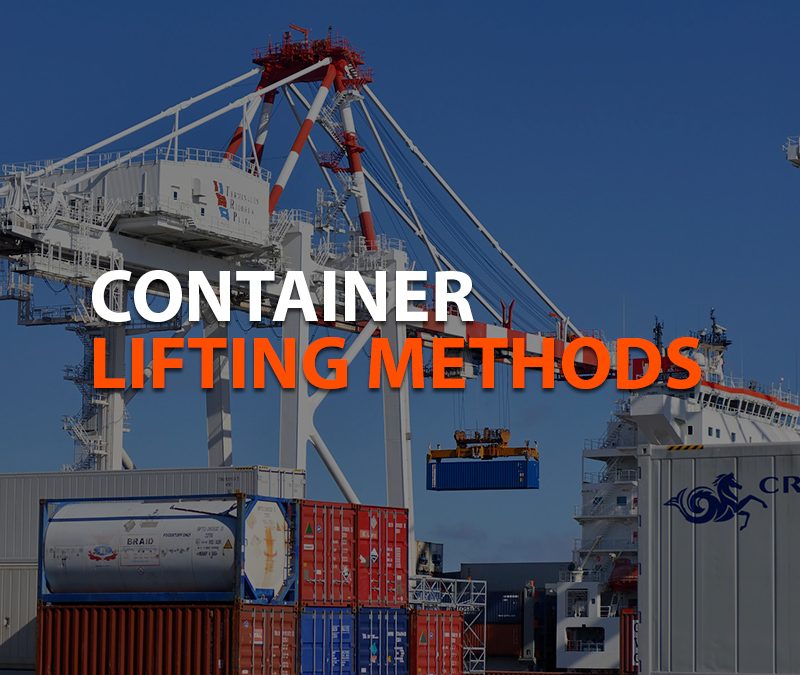In the world of transportation and storage of goods, containers are one of the most commonly used tools. These objects are ideal for protecting and transporting loads of all types, from food to heavy machinery. However, moving them from one place to another can be challenging due to their weight and size, that’s why we wrote a post about the types of cranes used for container lifting. Therefore, it is necessary to know the different lifting methods for containers of types A, B, C, D, and E.
Before we begin, it is important to understand that each type of container has distinct characteristics and, therefore, requires different lifting methods. Below, we will explain the most common techniques for each of them. Although, we must note that there are 5 lifting methods common to all types of containers: Top lift spreader, top lift sling, bottom lift sling and slide lift method 1 and 2.
Lifting methods
Top lift spreader method:
The “top lift spreader method” is a lifting technique that uses a specialized piece of equipment called a top lift spreader to attach to the top of a container and lift it off the ground. The spreader is connected to a hydraulic system that controls the lifting and lowering of the spreader arms, making it a versatile option for moving containers of different sizes and shapes. One of its advantages is that it requires less clearance space compared to other lifting methods.
Top lift sling method:
The “top lift sling method” is a lifting technique that uses slings to attach to the top of a container and lift it off the ground. The slings are attached to a crane or other lifting device that has the capacity to lift the weight of the container. This method requires more clearance space compared to the top lift spreader method, but it is a cost-effective option for moving containers.
Bottom lift sling method:
The “bottom lift sling method” is a lifting technique that uses slings to attach to the bottom of a container and lift it off the ground. The slings are attached to a crane or other lifting device that has the capacity to lift the weight of the container. This method is ideal for containers that are not designed to be lifted from the top, and it requires more clearance space compared to the top lift spreader method.
Slide lift methods (1,2 & 3):
The “slide lift methods” are a set of lifting techniques that involve using a sliding device, such as a skid or a low-profile trailer, to move containers. The container is first placed onto the sliding device and then pushed or pulled into position using a forklift or other equipment. This method is particularly useful for containers that are difficult to lift using traditional methods, such as those with uneven weight distribution or low clearance space. However, it requires additional equipment and may not be suitable for all types of containers.
End lift methods (1 & 2):
The “end lift methods” are a set of lifting techniques that involve using a lifting device, such as a crane or forklift, to lift the container from one end. This method is ideal for containers that are designed to be lifted from the ends, such as those with corner castings or lifting lugs. It requires sufficient clearance space for the lifting device, and the weight distribution of the container must be taken into consideration to ensure safe lifting.
Fork-Lift method:
The “fork lift method” is a lifting technique that uses a forklift to lift and move containers. The forklift has two prongs that slide under the container and lift it off the ground. This method is quick and efficient, but it requires a flat and stable surface for the forklift to operate safely. It is also limited to containers that have a flat bottom and are designed to be lifted by a forklift.
Now, we are going to see the types of containers (In a general way) that can be used for those lifting methods. If you want to know more about types of containers, check out our “The 8 most common types of containers” post.

General types of containers
Type A containers:
These containers are the most common and easiest to handle. To lift them, it is recommended to use a forklift, also known as a lift truck. This type of forklift has forks that adjust to the width of the container and are inserted underneath it to lift it. Once secured, the lift truck can move the container from one place to another without difficulty.
Type B containers:
Type B containers typically have a higher load capacity than Type A containers, making them heavier and more difficult to move. To lift them, it is recommended to use a forklift with a higher load capacity and, in some cases, a cargo hook. The hook is attached to the top edge of the container, and the forklift lifts it to the desired height.
Type C containers:
Type C containers are larger than Type A and B containers, making them more challenging to lift. To move them, telescopic boom cranes or mobile cranes are typically used. These machines have a high load capacity and can reach heights of up to 50 meters. They are used to lift the container and move it horizontally and vertically.
Type D containers:
Type D containers are the largest and heaviest of all. They are designed to transport extremely heavy or large loads, such as heavy machinery or construction pieces. To lift them, a specialized crane, such as a port crane or a gantry crane, is required. These machines have a high load capacity and can lift and move the container with ease.
Type E containers:
Type E containers are similar to Type D containers but are designed for even heavier loads. They are commonly used for transportation of large oil and gas equipment or other oversized cargoes. The lifting methods for Type E containers include floating cranes or heavy lift ships, which can lift the container from a barge or quay and move it to its destination.
All these types of containers to be lifted, normally, required container spreaders.
Summary of specified lifting methods:

In conclusion, containers are a fundamental tool in the transportation and storage of goods. To lift them, it is necessary to know the characteristics of each type of container and use the appropriate techniques. With the right lifting equipment and training, moving containers of any type can be done safely and efficiently.If you need more information, don’t hesitate to leave a comment or contact us







how do you lift a 40ft container with an uneven load cargoes? what kind of lifting sling if we used a quay crane
Hi Oliver, and thank you for your comment. Handling containers with uneven load is a complicated topic, with various implications depending on your particular situation. We have tried to summarize the most important points in the next article: “LIFTING 40 FT CONTAINER UNEVEN LOAD” we hope it helps!
The warehouse my cousin works at has a lot of containers to relocate this weekend. Thanks to you, I now realize the effectiveness of slinging and sliding methods in facilitating our lifting process. Hence, it would be better if he hires an equipment supplier to provide the best tool for such a task.